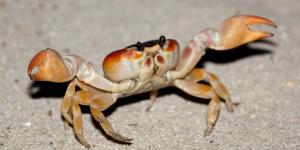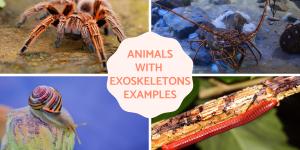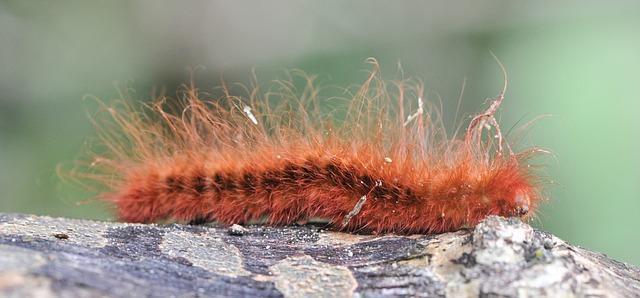Examples of Vertebrate and Invertebrate Animals


Are you looking for examples of vertebrate and invertebrate animals? Planet Earth has a very extensive biodiversity, traditionally classified into taxonomic ranks. These ranks are not always steadfast and scientists are regularly revising categories. The animal kingdom (Animalia) includes human beings. The species within this group are characterized by various factors, such as whether they feed on plants or other animals, or how they use sensory organs to interact with what's around them.
In turn, animals are classified into multiple sub-categories and ranks. We can make a general distinction by grouping vertebrate and invertebrate animals. Keep reading this AnimalWised article to discover the characteristics of both groups, the differences between them and examples of animals that belong to each one.
What are vertebrate animals?
The domain (i.e. the largest category) of all living things, including vertebrate and invertebrate animals, is split into three categories: Archea, Bacteria and Eukarya. Eukarya is the one which contains all multicellular organisms, including animals. This domain is split into a further five or six ‘kingdoms’: Animalia, Fungi, Plantae, Protista and Monera (which can be spit into Eubacteria and Archaebacteria).
Examples of vertebrate animals are found in the Animalia kingdom. Before we get on to our list of vertebrate animals, we can look at a vertebrate animals definition. The main characteristic of this group of animals is that they possess vertebrae. Commonly known as a spine, this is a highly specialized bone-type which joins together to compose a backbone. Its function is to protect and sustain the spinal cord and connect it to the nervous system. These animals are distinguished by their bilateral symmetry, and the fact that they have a skull to protect their brain.
The bodies of vertebrate animals are divided into head, trunk and limbs, while some species also have a tail. Another important feature is that vertebrates have different sexes. There are approximately 62,000 animal species that belong to this group, so we have a wide range to choose examples on our list.
One of the important ways to differentiate between vertebrates and invertebrates are their skeletons. Vertebrates will have some kind of endoskeleton. This means a skeleton which is on the inside of the body, either under the skin or under further tissue. This skeleton is not always made of bone. Some fish and marine animals, for example, have mainly cartilage to support their frame. One fish, known as the hagfish, has some debate over whether they are a vertebrate. Although they have a cranium (skull), they do not actually have vertebrae. Instead they have a notochord, similar to vertebrae in that it runs the length of their body, but which much more flexible and supple. This allows them to curl easily.
However, there are vertebrates which also have part of their skeleton on the outside (an exoskeleton)[1]. Examples include turtles which have the bones inside their body, but also have a hard shell which is used for protection. In fact, it is believed that the carapace (the turtle's shell) is derived purely form endoskeletal ribs[2]. Other reptiles have large scales on the outside of their skin which are used for protection.
The vertebrae is very important in housing the central nervous system of vertebrates. This system sends signals up and down the vertebrae to relay messages about movement, pain or any physical response the body might need. If the vertebrae is damaged, then these signals may not be able to transmit, resulting in incapacitation.
Grouping any animal, whether vertebrate or invertebrate, requires a very complicated taxonomic organization. The taxonomy (grouping) of the animal kingdom starts with all living organisms, subdividing into different parts from major groups into individual species. One stage in this subdivision is the phyla which can be loosely described as being grouped according to body structure. Whether or not an animal has a backbone is a very important aspect because it affects so many aspects of how they live and survive.

What are invertebrate animals?
To understand the differences between vertebrates and invertebrates, we need to look at them both in separate detail. We begin by providing some background on our list of invertebrate animals examples.
Invertebrates are characterized by their lack of vertebrae, i.e. they don't have a backbone. We don't mean this as a slight against their character, but invertebrates are often seen as being not as sophisticated as vertebrate animals. This is not true. They simply have a different anatomical structure and are adapted to their environment differently. Although we tend to think of vertebrates when we talk about animals, the truth is that invertebrates make up the majority of the animal kingdom at around 95% of all animal species.
Invertebrate animals aren't able to colonize territories or adapt to different environments, unlike vertebrate animals. Examples of invertebrates and their habitat include jellyfish which live in the sea, bees which fly in the air and earthworms which live partially underground.
No invertebrate will have a spine, but they can have a skeleton, i.e. a supporting structure. Many insects (such as the grasshopper seen in the picture below) are animals with exoskeletons which they may even shed. This supports and protects their body. A common example of an invertebrate with an exoskeleton is a cockroach which is infamous to humans for being resilient. However, there are invertebrates which have an endoskeleton. An octopus has an endoskeleton, although it is very soft and not made from bone like many vertebrates.
As there are so many more invertebrate species than vertebrates, their taxonomic groups are vast. There are different types of land animals such as insects and worms. This gives us many examples to choose for our list. However, these too are very broad groups and there are many different types of worms with various body structures.
Many marine animals are invertebrates and don't have a very rigid body structure, such as different types of jellyfish. This is not to mention other fascinating parts of their body structure such as tentacles[3] and the slime-like substance which constitutes most of their body. Whether an invertebrate lives in the ocean or the desert, there are various examples we can provide below.

Examples of vertebrate animals
Our list of vertebrate animals can be categorized into 5 main groups: mammals, birds, fish, amphibians and reptiles. The following are examples of vertebrate animals, some of them given by their generic names. For example, when we say ‘deer’, we mean that all species of deer are vertebrates. We can't give you a full vertebrate animals list as we don't have the space.
A list of animals with vertebrae will never be complete as we are discovering new animals all of the time. Fossil records show examples of extinct vertebrate animals, while new discoveries are being made regularly. For example, dinosaurs are extinct vertebrates, but they are related to extant reptile species. For this reason, we provide a list of vertebrates which are well known to give you an idea of what we mean.
Mammals:
- Bear
- Camel
- Cat
- Chimpanzee
- Chinchilla
- Cow
- Deer
- Dog
- Elephant
- Giraffe
- Gorilla
- Hippopotamus
- Horse
- Human
- Kangaroo
- Leopard
- Lynx
- Mouse
- Platypus
- Rabbit
- Rat
- Rhinoceros
- Sheep
- Tiger
- Titi monkey
Birds:
- Budgerigar
- Canary
- Crane
- Dove
- Duck
- Eagle
- Flamingo
- Goldfinch
- Heron
- Hummingbird
- Owl
- Parakeet
- Parrot
- Penguin
- Puffin
- Raven
- Robin
- Shoebill
- Toucan
Fish:
- Anglerfish
- Betta fish
- Catfish
- Eel
- Goldfish
- Lamprey
- Lungfish
- Mudskipper
- Pufferfish
- Ray
- Sea dragon
- Seahorse
- Shark
- Swordfish
- Tuna
Amphibians:
- Chinese giant salamander
- Common frog
- European fire-bellied toad
- Goliath frog
- Iberian ribbed newt
- Leaf green tree frog
- Panamanian golden frog
- Pool frog
- Red-eyed tree frog
- Rough-skinned newt
- Spotted salamander
- South American caecilian
- Tiger salamander
Reptiles:
- Alligator
- Bearded dragon
- Blind snake
- Boa
- Caiman
- Crocodile
- Cobra
- Gavial
- Iguana
- Komodo dragon
- Legless lizard
- Rattlesnake
- Tortoise
- Tuatara
- Turtle
- Viper
- Worm lizard

Difference between vertebrates and invertebrates
As you an see with the examples cited in this article, the diversity of animals is great. While the specific differences between each animal species are too numerous to mention, we can provide some general differences between vertebrates and invertebrates:
- Vertebrae: the first difference refers to the reason we classify them as vertebrates or invertebrates. The presence of a spine or backbone is the key difference between these two types of animals, but this is also a reflection of the differences in development.
- Size: the largest animal species ever recorded are vertebrates, and the smallest are invertebrates. While it is possible to cite examples of individual invertebrates being larger than individual vertebrates, they are relatively rare.
- Nervous system: generally speaking, vertebrate animals have a more highly-developed nervous system than invertebrates. The former's neurological processes are more complicated, but often also more vulnerable. This is also reflected in intelligence since invertebrates tend to rely more on instinct than intelligence. There are notable exceptions such as the octopus, thought to be one of the most intelligent animals in the world.
- Population: while vertebrates are larger in size, invertebrates are much larger in number. Invertebrates make up around 98% of the world's animal species, with populations of individual species often being much larger.
Examples of invertebrate animals
Invertebrates are not a taxon like vertebrates, but rather a generic name for all the animals that do not have a vertebral column or spine. There are millions of invertebrate species, as more animals do not have a spine than have one. This means making a list of all invertebrate animals would make this article too long. Instead, we can give a list of the different invertebrate animal groups with examples for each one.
Some invertebrates have shells, part of their exoskeletons. Others have a skeleton filled with fluid, that is, a hydrostatic skeleton. Some of them have legs, while others do not. We are also discovering fossil records for extinct invertebrate animals, but we are also discovering more invertebrate animals every day since there are so many of them. Among the best-known invertebrate phyla we can find the following (we have included examples of invertebrate animals to give you an idea):
- Annelids: ringed or segmented worms, including earthworms and leeches.
- Arthropods: animals with a segmented body, appendages and an exoskeleton, including arachnids like scorpions and spiders, crustaceans like crabs, lobsters and shrimp, and insects like ants, bees, beetles, butterflies, crickets, dragonflies, flies, grasshoppers, mosquitoes, moths, praying mantises and stick insects.
- Cnidaria: aquatic animals made up of a fluid substance, including corals, jellyfish and sea anemones.
- Echinoderms: spiny, radial marine animals including sea cucumbers, sea urchins and starfish.
- Molluscs: terrestrial and aquatic, include bivalves like mussels and oysters, cephalopods such as cuttlefish, squids and octopus and gastropods like slugs and snails.
- Porifora: jelly-textured animals with porous bodies through which water can circulate. Examples of invertebrate animals in this category are underwater sponges.

How are animals classified?
Owing to the large number of vertebrate and invertebrate animal species, it is practically impossible to make an exhaustive list that accounts for all animals. However, it is easy to differentiate them roughly and classify them depending on whether they have a spine or not.
There are many different ways of classifying animals. One of them is their morphology and anatomy - vertebrate or invertebrate - but animals are also classified according to their diet. Stay with us to discover:
If you want to read similar articles to Examples of Vertebrate and Invertebrate Animals, we recommend you visit our Facts about the animal kingdom category.
1. Biology Dictionary Editors. (2017). Endoskeleton:
https://biologydictionary.net/endoskeleton/
2. Hirasawa, T., Nagashima, H., & Kuratani, S. (2013). The endoskeletal origin of the turtle carapace. Nature communications, 4, 2107. https://doi.org/10.1038/ncomms3107
https://www.nature.com/articles/ncomms3107
3. Gold, D. A., Nakanishi, N., Hensley, N. M., Cozzolino, K., Tabatabaee, M., Martin, M., Hartenstein, V., & Jacobs, D. K. (2015). Structural and Developmental Disparity in the Tentacles of the Moon Jellyfish Aurelia sp.1. PloS one, 10(8), e0134741.
https://journals.plos.org/plosone/article?id=10.1371/journal.pone.0134741







 its very useful i love it
its very useful i love it

 It's useful
It's useful



